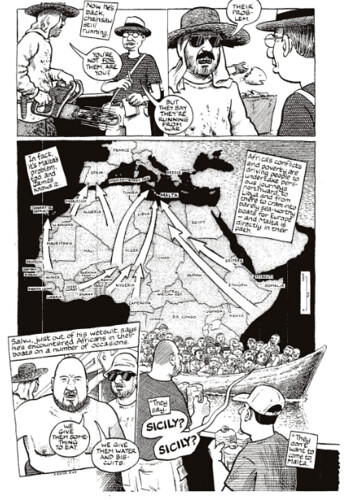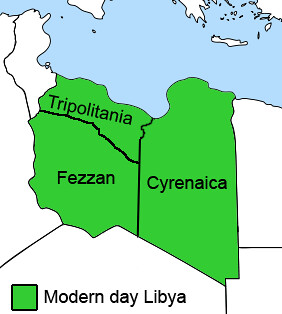That's not the only way it's been seen. In fact, this time last century the situation was precisely the reverse. As small islands sometimes overpopulated relative to the productive capacity of their once-agricultural/military-driven economy part of the British global empire, from the mid-19th century on Malta experienced massive emigration, tens after tens of thousands of Maltese emigrants making their way throughout the British Empire and later Commonwealth and beyond. Some settled in Canada, for instance, the nucleus of the Maltese-Canadian community (as described by Shawn Micallef) lying here in Toronto just a couple of subway stops to the west of my home beyond its eventual dispersal. Many Maltese chose not to leave home so far behind and instead immigrated to French North Africa, to the Algeria colonized since 1830 and the Tunisia made a protectorate from 1881. There, Maltese immigrants came to play critical roles in the colonization of North African territories at a time when population pressures in Europe made the organized settlement of the southern rim of the Mediterranean Sea by Europeans seem a sensible idea.
Algeria was for many years the most important country for Maltese migration within the zone of the Mediterranean. Under various aspects it was also the most successful and statistics show that by the middle of the nineteenth century more than half of Malta's emigrants had chosen Algeria as their country of residence. Although the French conquest had began in 1830, some Maltese had found their way to the area around the city of Constantine before the French connection had began. In 1834 a French governor for North Africa had been appointed, and as the French consolidated their foothold on Algerian territory, Europeans followed the French tricolor. Among the Europeans the Maltese were one of the largest groups, being outnumbered only by Spaniards and Sicilians.
Like all newcomers, the Maltese in Algeria did at first encounter hostility from the French. Continental Europeans looked down on other Europeans who came from the islands such as the Sicilians and the Maltese. It is true to admit that most insular Europeans were poor and illiterate. Some did have a criminal record and were only too ready to carry on with their way of life in other parts of the Mediterranean where their names were not publicly known.
French official policy was dictated by sheer necessity. France was a large and prosperous country. Its population was not enormous and many French peasants were quite happy with their lot. If the French needed colonists to make their presence permanent they had to turn to other sources to obtain their manpower. The French Consul in Malta was in favour of encouraging Maltese emigrants to settle in Algeria. He believed that the Maltese showed a distinct liking for France and the French. Although the Maltese under the British, they were not politically active and the French could accept them without any fear.
Another important man who favoured Maltese emigration to North Africa in general and to Algeria in particular was the prominent French churchman, Cardinal Charles Lavigeric who had dreams of converting the Maghreb back to Christianity. Lavigerie saw North Africa in historical terms as he was professor of Church history. He founded a religious order which was . commonly called "The White Fathers" with scope of spreading Christianity among the .Berbers and the Arabs. Cardinal Lavigerie was archbishop of Carthage and Algiers. In 1882 Cardinal Lavigerie visited Malta. He immediately appreciated the Catholic fervour of the islanders. During his stay he talked of the Maltese as providential instruments meant to augment the Christian population of French North Africa. He saw the Maltese as loyal to France and to the Catholic Church and at the same time as being eminently useful in building some form of communication with the Arab masses.
[. . .]
By 1847 the number of Maltese living in Algeria was calculated at 4,610. The Maltese colony in Algeria had been realised as being of some importance by that date, so much so that Maltese church leaders decided to send two priests during Lent to deliver sermons in Maltese.
In a letter written by the Governor General of ,Algeria on June 17, 1903, it was stated that by then there were 15,000 inhabitants who claimed Maltese origin. Most of these were small farmers, fishermen and traders. As in other parts of North Africa, the Maltese ability to speak in three or four languages helped them to get on well with the French, Spaniards, Italians and Arabs.
In 1926 the number of ethnic Maltese living in Algeria and Tunisia was tentatively calculated at about 30,000. The exact number of Maltese in was impossible to arrive at because many Maltese had opted for French nationality. By 1927 the Maltese were considered as excellent settlers who worked very hard and were honest in their dealings with others. This was the judgement given by Monsieur Emile Morinaud, a Deputy for Algiers in Paris. In a speech delivered by Morinaud on November 30, 1927, the French politician declared the Maltese as being "French at heart".
Settlement in Tunisia began later.
When Napoleon Bonaparte captured Malta from the Knights of St. John in 1798 he ordered the Bay of Tunis to free all the Maltese slaves who languished in jail. At least fifty such slaves returned to Malta. For centuries the Maltese who found themselves in Tunis probably did so against their will. With the advent of the Napoleonic Era and the re-structuring of political power in Europe and along the shores of the Mediterranean, the pirates of Tunis lost their trade. The foothold gained by the French in North Africa changed the political framework of the Maghreb and some Europeans thought, somewhat prematurely, that the Mediterranean was to enter into another Roman Epoch. with peace reigning all along its coasts.
The Maltese were among the first to venture in their speronaras into Tunisian waters. They traded with coastal towns and with the island of Jerba. Eventually they established settlements not only in Tunis and on jerba but also in Susa, Monastir, Mehdia and Sfax. By 1842 there were about 3,000 Maltese in the Regency. In less than twenty years their numbers increased to 7,000.
[. . .]
The French had one serious preoccupation in Tunisia. Italian immigrants had settled there in their thousands and Italy had coveted Tunisia for a very long time. The French occupation of Tunisia had gone down very badly with the Italians. The French wanted the Maltese to act as a counter-balance to the Italians. British consular statistics show that by the beginning of the twentieth century there were 15,326 Maltese living in Tunisia.
The Maltese in Tunisia worked on farms, on the railways, in the ports and in small industries. They introduced different types of fruit trees which they had brought with them from Malta. Moreover contact between Malta and Tunisia was constant because the small boats owned by the Maltese, popularly known as speronaras, constantly plied the narrow waters between Tunisia and the Maltese Islands.
Paul Cambon referred to the Maltese living in Tunisia as the "Anglo-Maltese Element". He was grateful that such an element proved to be either loyal to France or at least was politically neutral. In spite of rampant anti-clericalism in France, the French allowed the Maltese complete freedom of their religion. Cardinal Lavigerie was respected. The fiery leader of French anti-clericalism, Leon Gambetta, did not hesitate to state that when French priests spread not only religion but French culture, then they were to be allowed to carry on with their work without any restraint.
After 1900 it became legally possible for foreigners to buy land in Tunisia. After that year there was a number of Maltese landowners in that country. In 1912 trade between Tunisia and Malta had risen to more than two million francs. Cultural ties were kept alive by the frequent visits brass bands from Malta which were often invited to cross the water to help create a festive -mood when the Maltese in Tunisia celebrated the feast of their parish. On April 10, 1926, a Maltese newspaper commented on a visit made by the French President to Tunisia. The newspaper claimed that the President, Emile Loubet, had eulogised the Maltese as "a model colony".
Go, read, and reflect on the interesting ways in which history can more than reverse itself in short periods of time. Malta wasn't the territory experiencing pressure from ill-regulated immigration; Maltese, rather, were settlers making new homes in the conquered territories just beyond the horizon.





